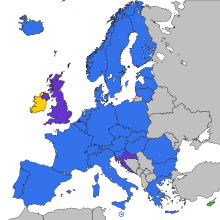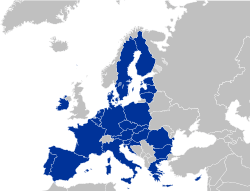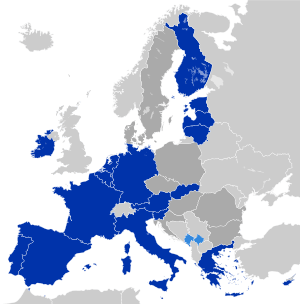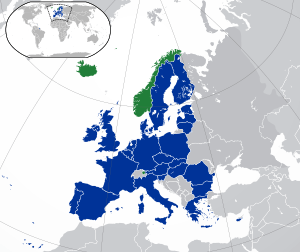Schengen Information System
The Schengen Information System (SIS) is a governmental database maintained by the European Commission. The SIS is used by 31 European countries to find information about individuals and entities for the purposes of national security, border control and law enforcement since 2001. A second technical version of this system, SIS II, went live on 9 April 2013.[1]

Participating nations
Information in SIS is shared among the institutions of countries participating in the Schengen Agreement Application Convention (SAAC). The five original participating countries were France, Germany, Belgium, the Netherlands, and Luxembourg. Twenty-one additional countries have joined the system since its creation: Spain, Portugal, Italy, Austria, Greece, Finland, Sweden, Switzerland, Denmark, Iceland, Norway, Estonia, the Czech Republic, Hungary, Latvia, Lithuania, Malta, Poland, Slovakia, Slovenia and Liechtenstein. Among the current participants, Iceland, Liechtenstein, Norway, and Switzerland are not members of the European Union.
Although Ireland and the United Kingdom have not signed the Schengen Agreement Application Convention, they take part in Schengen co-operation under the terms of the Treaty of Amsterdam, which introduced the provisions of Schengen acquis into European Union law. Schengen acquis allows the United Kingdom and Ireland to take part in all or part of the Schengen convention arrangements. Ireland and the United Kingdom use the Schengen Information System for law enforcement purposes.[2]
Ireland and the United Kingdom do not have access to Article 26D (former 96) data because these countries do not intend to remove the border controls between themselves and the rest of Europe. European citizens still have the right of free movement to the UK and Ireland but must pass through a border control point, unlike the other Schengen signatory countries, among whom internal border controls have been largely abolished. Since 1 August 2018, Bulgaria and Romania have full access to SIS; before that they had access to SIS only for law enforcement purposes.[3] Croatia has access to SIS for law enforcement purposes, while Cyprus does not have any access.
The UK did 571 millions searches in the database in 2019[4].
Introduction
SIS information is stored according to the legislation of each participating country. There are more than 46 million entries (called "alerts") in SIS, most about lost identity documents.[5] Person alerts make up around 1.9 percent of the database (about 885,000 records). Each alert contains information such as: name, date of birth, gender, nationality, aliases, arms or history of violence, the reason for the alert and the action to be taken if the person is encountered. SIS does not record travellers' entries and exits from the Schengen Area.[6][7][8][9]
History
On 25 March 1957, the Treaty of Rome was completed. On 3 February 1958, the economic union of the Benelux countries was formed. Both agreements aimed to enable the free movement of people and goods across national borders. The Benelux countries, as a smaller group, were able to quickly implement the agreement. The European Communities' focus was on economic integration. It was not until the agreement of Saarbrücken was completed on 13 July 1984, that border controls between France and Germany were eased.
On 14 June 1985, France, Germany and three of the Benelux nations completed the Schengen Agreement. Border controls on people and goods between these nations were gradually relaxed. On 19 June 1990, the initial five nations were joined by Spain, Portugal, Italy, Greece, Austria and five Nordic Passport Union countries: Denmark, Finland, Iceland, Norway and Sweden.
On 21 December 2007, the Schengen border-free zone was enlarged to include Estonia, the Czech Republic, Hungary, Latvia, Lithuania, Malta, Poland, Slovakia and Slovenia.
Legal aspects and technical characteristics
SIS was created to maintain European security after 25 March 2001 when border security between fifteen nations was relaxed. The SIS requires Schengen nations to respect the legal force of the information it contains. It also requires the nations to respect the privacy and personal freedom of the people whose data is held according to national data laws. SIS's information processing system must be permanently connected to member nations' databases and must be updated in real-time.
These commitments are supplemented by consultation procedures between the member nations. Discussions may take place about issues such as confirmation of information, variation of actions directed by SIS, questions of residency, and international warrants for arrest.
SIS is controlled by an authority composed of representatives of the member nations. Personal data protection is a key responsibility. At a technical level, the participating countries adopted a data-processing star architecture made up of a central site containing the reference database, known as C-SIS, for which the responsibility is entrusted to the French Republic by the CAAS, and a site by country, known as N-SIS, containing a copy of the database.
Data
The type of data about people kept in SIS includes: requests for extradition; undesirability of presence in particular territory; minor age; mental illnesses; missing person status; a need for protection; requests by a judicial authority; and suspected of crime. The SIS also keeps data referring to lost, stolen and misappropriated firearms, identity documents, motor vehicles and banknotes.
France is responsible for management of SIS and uses an automated system of data updates which occur every five minutes. The SIS automatically directs data to queries arriving via large national databases. Each member nation has an office responsible for SIS communications. SIS also has a function called "Supplementary Information Request at the National Entry" (SIRENE). The SIRENE office records an "hit" on a SIS data record and forwards further information to assist investigations.
Police co-operation and legal mutual assistance
In addition to SIS and SIRENE, the Schengen convention ensured police co-operation and legal mutual assistance. Police of member nations can cooperate to prevent and identify crime (article 39); to continue surveillance across borders (article 40); to pursue across borders in certain circumstances (article 41); and to share information that is significant for the repression or the prevention of in flagrante delicto or threats to order and public safety (article 46). This allows execution of criminal judgements and extraditions where a national attempts to take refuge in another territory.
System evolution
In November 2011, SIS1 was renewed for a second time. The main reason for renewal was to connect more nations.
In 2007, while developments were in progress, Portugal had offered the use of a version called "SISone4ALL" developed by SEF (Portugal's Border and Foreigners Service) and Critical Software.[10]
On 15 October 2010, Bulgaria and Romania joined SIS II for law enforcement cooperation.[11]
On 9 April 2013, SIS II went live.[1][12]
On 27 June 2017, Croatia joined SIS II for law enforcement cooperation.[13]
On 1 August 2018, Bulgaria and Romania gained full access to SIS.[14]
As of January 2020, Ireland had achieved "technical readiness" to participate and anctipated that it would begin "phased implementation" during the first quarter of 2020.[15]
Brexit
With Brexit, the use of the Schengen Information System by the UK is under negotiation, while the EU expects the UK to comply with the EU law to use it. In June 2020, the Security and Intelligence subcommittee of the House of Lords, on hearing evidence by Home Office Minister James Brokenshire, expressed concerns that failure of the (post-Brexit) trade negotiation between the UK and the EU could lead to worrying delays in access to counter-terrorism intelligence.[16]
See also
References
- http://europa.eu/rapid/press-release_IP-13-309_en.pdf
- "EUR-Lex - l33020 - EN - EUR-Lex". europa.eu.
- https://www.theguardian.com/politics/2020/may/22/uk-and-eu-brexit-talks-clash-over-crime-fighting-database
- SIS Statewatch 2013
- Commission staff working document: impact assessment report on the establishment of an EU entry exit system Eulex 6 April 2016 p 11 Accessed 19 April 2017
- Proposal for a regulation of the European parliament and of the council establishing an entry/exit system (EES) to register entry and exit data of third country nationals crossing the external borders of the member states of the European Union Europa p 2. Accessed 12 October 2013.
- Council of the European Union: questionnaire on the possible creation of a system of electronic recording of entries and exits of third country nationals in the Schengen area (reply from Greece) Statewatch 2013.
- Smart borders for an open and secure Europe Europa.
- SISone4all Critical software.
- council decision 29 June 2010 on the application of the provisions of the Schengen acquis relating to the Schengen Information System in the Republic of Bulgaria and Romania (2010/365/EU) Europa
- Proposition de résolution Le système d'information Schengen Senat.fr
- Council decision (EU) 2017/733 of 25 April 2017 on the application of the provisions of the Schengen acquis relating to the Schengen Information System in the Republic of Croatia Europa.
- "Ireland to plug into EU security system as Schengen II kicks in". Law Society Gazette Ireland. 23 January 2020. Retrieved 16 June 2020.
- Lisa O'Carroll (16 June 2020). "Failure of Brexit talks could lead to terrorism intelligence delays, say Lords. Real-time access to EU police databases has not yet been agreed in the negotiations". The Guardian. Retrieved 16 June 2020.
Lord Ricketts, a former diplomat and the chair of the committee, questioned the “coherence” of the UK’s Brexit approach. It was looking for a Canada-style agreement in trade but a specially close arrangement in security and justice, “an equivalent position to that which perhaps Schengen countries have, or EEA countries have like Norway, Iceland but no other country”, he said.



